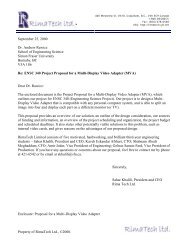Fleksibilni Internet servisi na bazi kontrole kašnjenja i
Fleksibilni Internet servisi na bazi kontrole kašnjenja i
Fleksibilni Internet servisi na bazi kontrole kašnjenja i
You also want an ePaper? Increase the reach of your titles
YUMPU automatically turns print PDFs into web optimized ePapers that Google loves.
DS queue with probabilities rTS/C and rDS/C, respectively.<br />
5.3. Performances of BPR and BPR +<br />
In the following simulation sce<strong>na</strong>rios, we evaluate the ability of BPR scheduler to<br />
provide proportio<strong>na</strong>l delay differentiation between the throughput-sensitive and delay-<br />
sensitive class. We compare its performance with the performance of BPR + in order to<br />
evaluate the performance improvement that could be achieved by considering arrival<br />
times of backlogged packets.<br />
The simulated topology in ns-2 network simulator [31] is shown in Fig. 11. There<br />
are NTS=5 throughput-sensitive sources and NDS=5 delay-sensitive sources sending their<br />
packets to the sink. All sources are ON/OFF Pareto sources with average packet size of<br />
500 bytes, average durations of ON and OFF periods 50 ms, and shape parameter 1.5.<br />
Capacities and propagation delays of links are indicated in Fig. 11. BPR and BPR + are<br />
implemented in the access router R. The capacity of the output buffer in the router is 250<br />
packets, except for the sce<strong>na</strong>rio where we vary the buffer size.<br />
Fig. 11. Simulated topology used for evaluating the performances of BPR and BPR + .<br />
37






